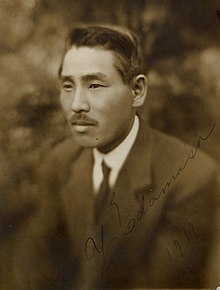|
Yoshirō Edamasa
Yoshirō Edamasa (枝正 義郎, Edamasa Yoshirō, 22 September 1888 – 8 September 1944) was a Japanese film director best known for Sakamoto Ryoma (1928) and The Great Buddha Arrival (1934).[2] The latter film is one of the earliest tokusatsu movies, which is exemplified by kaiju movies.[3] He was an early pioneer of Japanese cinema who trained many outstanding directors and cinematographers including Eiji Tsuburaya.[4] LifeEdamasa was born in Kushima, Saeki, Hiroshima Prefecture (present-day Hatsukaichi, Hiroshima).[5] In 1910, he began working in the film industry when he was hired by Yoshizawa Shōten.[1] He later worked as an operator also for Fukuhōdō , Tōyō Shōkai and Tenkatsu Nippori.[1] He made his debut as a director in 1919 on the film Ai no kyoku which was considered to be one of the most advanced films of that time.[6] By the end of the 1930s, Edamasa had directed more than 20 films.[1] Edamasa belonged to a group of directors who emphasized the realistic style of acting.[7] Selected filmography
References
External links |
||||||||||||||
Portal di Ensiklopedia Dunia
